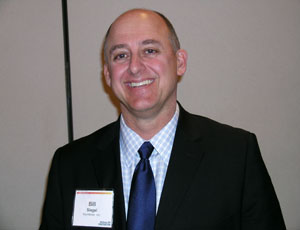Adjust to the new realities, give employees a cause to fight for and focus on opportunities.
That�s how leaders of three design and construction companies described methods of fending off despair and rallying staffs during the financial crisis that has engulfed global economies and the construction industry. They joined other market sector leaders from industry, government and Wall Street to analyze current realities and optimize solutions at �Managing Construction�s Financial Crisis,� an ENR/McGraw-Hill Construction-sponsored conference in New York City Feb. 24-25.

Ira Levy, president of AECOM’s DMJM Harris unit in New York City, put it this way: “Will revenue shrink? Most probably. Will profits shrink as much? Not necessarily.” A better question to ask, said Levy, is, “When the economy comes back, will your company be on top?” He urged other managers to create a vision for the future and to be prepared to “capture the upswing.”
Levy made his remarks amid other presentations about worsening economic condition and about whether large project infrastructure debt financing can get back on its feet. Disparaging the “doom and gloom” he has encountered at other conferences, Levy projected an air of determination. Like President Barack Obama, who made an upbeat nationwide address the evening of Feb. 24, Levy and the two other company executives predicted a bright economic morning that eventually will dawn.
But first the industry has to get through the night, as sources of private sector project finance remain sluggish. Among the realities faced by design and construction companies, said Levy, is that “government may be our client more than ever,” projects will drag out, cash flows will deteriorate and litigation will swell. More work will have to be done in-house, causing subcontractors to suffer, he said.
Levy said that the stimulus didn’t contain a “process to get the cash out,” and because the money was being funded in the style of a block grant, obtaining payments may be excruciating. “So when you start putting in the invoices, there will be crisis to get the money out,” he predicted.
Given those realities, business “is not zero,” and goes on, Levy said.
Stewart Murray, director of infrastructure and energy finance at New York investment bank Citi, noted that “it’s not a pretty picture, but in many sectors, it’s not as bad as everyone thinks.” He said that investors are “piling money” into investment grade bonds,” which was “good news for utilities to have access to cash at good rates.” But he acknowledged that the equity marked is “depressed, and that banks around the world have less capacity and less capital to put into projects.”
Murray added as banks cost of capital rises, “they must charge more for loans they make and authorize them for shorter durations.” He noted that banks “are looking for the most solid credit and tightest risk, and are focusing on core relationships.” According to Murray, raising $1 billion for project finance was “highly achievable” a year ago. “Now it’s testing a bank’s market capacity.” Financiers now have “less appetite” for a project’s merchant risk,” he noted. Murray said lenders would be more highly valuing projects under engineer-procure-construction type (EPC) contracts.
Michael Kappaz, CEO of K&M Group of Cos., a power plant developer-builder a former Bechtel Power vice president, noted that smaller energy projects will be most favored. “We must collectively make sense of the crisis and structure projects that make sense,” he said.
The crisis could affect the progress of planned nuclear power megaprojects, but proponents say perceived demand will keep the market in gear and that safety issues are less of an obstacle. Bob Percopo, executive vice president of AIG Global Marine & Energy, noted that the firm has been a “big supporter of wind and solar projects, but it’s not enough.” He noted that for nuclear power to make up 30% of the US power mix by 2035, “that’s 95 new plants. That’s a lot. But we seem to be more interested in debating technologies than putting them in place.”
In the transportation funding arena, Cheryl Jones, the U.S. Transportation Dept.’s senior project finance advisor its TIFIA innovative finance program, emphasized that the current stimulus package “was not the entire solution.” She contended that the current credit tightening has boosted interest in the TIFIA program “to an all time high. “We have favorable terms for large projects that need time to produce revenue.” Pamela Bailey-Campbell, senior vice president at Parsons Brinckerhoff, noted that “a huge hole in this crisis is the absence of bond insurers. TIFIA can play that role by funding a project’s pre-development costs. TIFIA is more powerful in its leverage than banks for transportation projects.”
Campbell hinted that that the current economic pinch could ease by 2010, “but it depends on how many other shoes fall.”
In the meantime, finding a core around which to rally employees is critical, said Charlie Bacon, CEO of Limbach Facility Services, Pittsburgh. He noted how his company, once owned by Enron, endured the crisis of the parent’s demise in 2000 and saved its market share following a management buyout by rallying demoralized staffers around the cause of safety. “At Limbach, people believed safety saved the company,” said Bacon. “I don’t know what you have in your business to rally around,” he added, suggesting that environmentalism could help to inspire employees. “We have a lot of young people and college graduates and they expect us to save the planet,” he said.
Motivating employees whose company stock holdings have fallen in value in recent months is a growing challenge for CEOs, noted Bill Siegel, who will take over in April as CEO at Kleinfelder Inc., the San Diego-based engineering firm. But he told conference attendees: “Don’t forget the future. We still have a $14-trillion economy and things do turn around. So outcompete the competition, and keep an eye on the future.” Siegel added that “when time are tough, great teams steal market share.”






Post a comment to this article
Report Abusive Comment